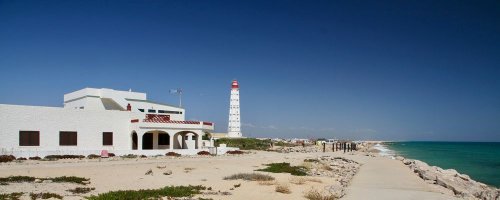If you want to avoid the tourist plagues in Portugal (July and August) then head to the Algarve's coastline during the shoulder season, when the prices are lower. You also won’t be hustling for a bit of personal space whilst walking around, ferry hopping, or scoffing your food down quickly with a queue of people glaring at you, as they impatiently wait for you to vacate your table.

Olhão, sitting just south of Faro, has a constant run throughout the day of ferries to take you to the barrier islands (huge sand bars) that shelter the Parque Natural da Ria Formosa from the incessant pounding of the open sea. The ferry ride is an adventure in itself, as big-boy toys (boats) whizz past the snail-paced ferry, and fishing boats chug along, whilst locals bob up and down on mud flats picking up a feast of cockles and mussels. It takes 30 minutes to get to Culatra from the jetty at Olhão and a further 10 minutes if you wish to go to Farol. You can always arrive at one fishing village and depart from the other, if you have gone walkabout.

Culatra Island is where you can get a real sense of the life of a traditional fishing village devoid of any modern day hype. Totally car-free, with basic amenities, walking around Culatra will charm you with its simplicity, stunning beaches and some of the best seafood restaurants in the whole of the Algarve. The island has two fishing villages; one simply named Culatra, and on the western side, Farol, where the iconic lipstick-red-topped lighthouse sits.

You can walk the mud flats via wooden walkways (the closest thing the island has that could be called a roadway) from one end of the island to the other, if you are into a bit of self-punishment or merely a hyperactive person. About 1,000 souls inhabit the island all year round, relying on fishing and tourism to make a living, whilst taking plenty of trips with caddies in tow on the ferry to Olhão to stack up on food and daily requirements.

A mess of boats of all shapes and sizes dot the shoreline on the lagoon side, and whitewashed bougainvillea-draped cottages squat beside each other in a long line on the way to the surf beach. A never-ending wooden walkway will lead you through the mud flat areas to the massive sand dunes hiding a pristine beach that is complete with sun loungers and umbrellas that you can rent by the hour or the day.

While not exactly a cheap way to enjoy sun worshipping, it is however, the most convenient, if you are not into lugging your own brolly and chair over the 10-minute walk to the beach, let alone lugging these cumbersome items with you onto the ferry. A beach cafe complete with funky plastic chairs under an umbrella services the bronzed bodies on the surf beach, so you don't have to despair if you didn't BYO food or liquids in a hefty cooler, as many appear to do.


A cluster of homes squat by the jetty, plus a few restaurants and cafes where you can grab a coffee on arrival or chow down on mouth-watering seafood with an incredible view over crystal-clear water, as far as the eye can see. To dip your toes in the chilly sea, you can take your pick from calm lagoons or head to the pounding waves, depending on whether you have littlies in tow or not. Sparsely developed, both villages do cater to the tourists that arrive like an onslaught of locusts during the summer months. When you want a bit of isolation in sun-worshipping mode, the further you walk along the long stretch of sand, the less people you will come across.
Said to be one of the most beautiful beaches in the whole of the Algarve, Ilha da Culatra will have you hankering for your own fisherman shack to stay in for a while, so that you can hang in chill-out bliss with the local fishermen and strain the brain thinking about the weather or gazing at fluffy clouds on the horizon.
Gail Palethorpe, a self proclaimed Australian gypsy, is a freelance writer, photographer and eternal traveller. Check out her website Gail Palethorpe Photography and her Shutterstock profile.















